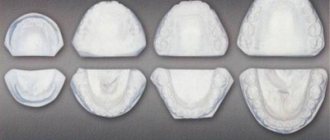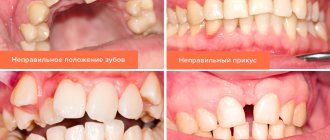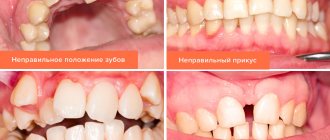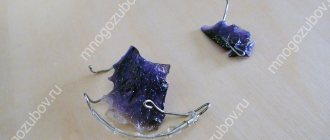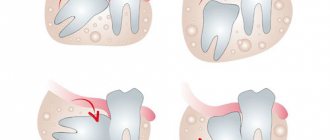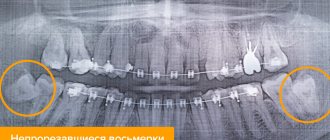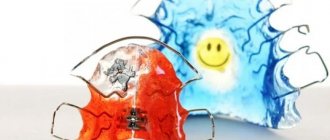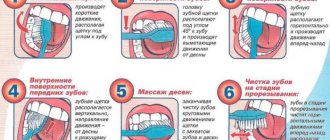British scientists claim that 8 out of 10 people have crooked teeth. At first glance, slight crooked teeth are not such a global problem. Indeed, most people don't even think about why their teeth become crooked and simply ignore this dental problem. But in fact, crooked front (lower or upper) teeth can not only cause psychological discomfort, but also cause serious health problems.
Why do teeth become crooked?
It is quite difficult to figure out why teeth are crooked, since there are many reasons for this anomaly. But there are factors that help explain why teeth grow crooked:
- Personality characteristics: narrow jaw and large teeth that simply do not have enough space in the mouth to grow straight.
- Bad habits: thumb sucking or using a pacifier for too long in children, lip biting, pencil chewing. All these habits lead to the fact that the teeth do not close completely, and the upper or lower jaw lengthens.
- Refusal to treat baby teeth. Unfortunately, there are still dentists who claim that caries in baby teeth does not need to be treated and simply remove the child’s diseased tooth. This cannot be done, since early removal of a baby tooth will lead to displacement and curvature of the entire dentition.
- Mouth breathing: If a person breathes only through the mouth, the shape of the palate gradually changes, which can also cause crooked teeth.
But most of the factors associated with crooked front or any other teeth are laid down in childhood, even in the womb. During the formation of the fetus, dental anomalies of one of the parents can be transmitted to the baby. But even if a child does not have a genetic predisposition, crooked teeth may still appear.
The reasons will be explained by orthopedic dentist of the 32Dent clinic Lyudmila Vladimirovna Ponomareva: “Most dental problems begin in childhood. This also applies to the causes of crooked teeth. If a baby is fed from a nipple with a hole that is too large, he will not make any effort to suck and jaw growth will not be stimulated. This also applies to nutrition: a child’s diet should contain a certain amount of hard food. Thanks to this, baby teeth wear down evenly and jaw growth is stimulated.”
But even if you know exactly why your teeth are crooked, it doesn’t change anything. Unfortunately, there are few qualified dentists who can eliminate malocclusion, and correcting crooked teeth in adults and adolescents is a rather lengthy process.
Jaw position and teeth closure
Normally, the lower jaw should neither protrude forward nor be pushed back relative to the upper jaw. Ideally, the upper teeth touch the lower teeth and slightly overlap them - by about a third. This means that when the teeth are tightly closed, the lower teeth will be visible.
- The lower teeth are not visible at all; the upper teeth completely cover them? Perhaps it's a deep bite.
Deep bite: the lower teeth overlap the upper teeth too much, the height of the bite is reduced
- Are the lower teeth in front of the upper teeth, especially in the anterior region (front)? Probably mesial overbite.
Mesial bite: the lower jaw is pushed forward
- The upper teeth do not overlap the lower ones, but rather touch them with their cutting edges? It appears to be a straight bite.
Straight bite: the smile may look beautiful, but the closure is incorrect and there is no overlap
- Do your upper teeth protrude too far forward, but your lower teeth cannot reach them? This happens with a distal bite.
Distal bite: the lower jaw does not reach the upper jaw
- The dentitions intersect with each other. On one side, the upper teeth protrude forward, and on the other, the lower teeth. It is imperative to consult an orthodontist, as this may be a crossbite.
Crossbite: the dentition intersects like a “scissors.”
It is necessary to examine not only the front teeth, but also the lateral teeth in a closed state. If only one lower tooth protrudes forward and covers the upper one, you can already think about a crossbite (only a doctor can make a final diagnosis).
Types and degrees of curvature
The method of restoring crooked teeth depends on the degree of curvature and the age of the patient. On the Internet you can find many photos of celebrities with crooked teeth before and after restoration. How does the correction process work?
First, let's look at the degrees of curvature:
- First degree: refers to individual teeth that differ from the rest in shape, size or location.
- Crooked teeth 2 degrees: incorrectly formed dentition due to the simultaneous eruption of several teeth at once.
- Third degree: curvature at the level of the jaws, which leads to improper closure of the upper and lower dentition.
In addition, the front teeth, incisors or wisdom teeth may be crooked. The front ones, as a rule, change shape or location due to external factors: injuries, the habit of chewing a pen or seeds.
Orthodontist Anastasia Sergeevna Arkhangelskaya from the 32 Dent clinic explains why teeth grow crooked in adults: “In adulthood, people often have to have their teeth removed. If an implant or other prosthesis is not installed in their place, the dentition may become crooked. In addition, the development of dental anomalies is facilitated by the eruption of wisdom teeth. This is especially true for people with a narrow jaw, which simply does not have enough space for large wisdom teeth.”
If you have a problem similar to that described in this article, be sure to contact our specialists. Don't diagnose yourself!
Why you should call us now:
- We will answer all your questions in 3 minutes
- Free consultation
- The average work experience of doctors is 12 years
- Convenient location of clinics
Single contact phone number: +7
Make an appointment
Mesial bite
Mesial occlusion or, as they also say, mesial occlusion is the second common malocclusion in the sagittal plane. And although mesial occlusion is less common than distal occlusion, there are no fewer questions and controversies surrounding its diagnosis and treatment.
Mesial occlusion is characterized by the fact that the closure of the dentition is visually observed in the so-called third class. When the anterior buccal cusp of the upper molar does not lie in the median fissure of the lower molar, but is located dorsally (posteriorly) from it. And the upper canine is positioned not between the lower canine and the lower first premolar, but also more dorsally. As a result, the normal relationships of the dentition are disrupted.
And we see that the lower row of teeth protrudes forward, more than expected, in relation to the upper teeth. But third grade closure is not a diagnosis. Just as the formulation itself is not a diagnosis - mesial occlusion or mesial occlusion. The closure of teeth, both in the third and, in principle, in any class, is just the closure of teeth. No more. Some external sign. It does not reflect the cause of any anomaly. Moreover, sometimes the closing of teeth even camouflages (hides, hides) the main, usually skeletal, problem. And therefore, just as in the case of treating distal occlusion, or any other problem, you should not make a diagnosis and build treatment tactics only by the type of closure of the teeth. This guideline is extremely unreliable and deceptive. Always and everywhere it is necessary to treat not the “third (or second) class”, but the very cause of the problem that led to this class of closure. Of course, this reason must first be determined. Well, more on that below.
For now, let’s look at the external signs that allow us to suspect mesial occlusion in a patient.
Mesial bite. Signs
At the level of the teeth, as already said, the lower teeth protrude forward in relation to the upper ones. The degree of their “protrusion” can vary from the closure of the upper and lower incisors “joint to joint” (the so-called straight bite)
or a slight “divergence” of the upper and lower incisors along the sagittal, or in other words, in the anteroposterior direction (reverse incisal overlap or reverse bite). Until there is a pronounced non-closure of the upper and lower incisors in the sagittal plane with the formation of a sagittal gap.
Only in this case, unlike distal occlusion, the “components” of the sagittal fissure (upper and lower teeth) have opposite (inverse) relationships. In the case of a pronounced sagittal gap and non-closure of the teeth, the diagnosis will sound like reverse incisal disocclusion (disocclusion - lack of closure). The vertical relationship of the teeth and jaws with mesial occlusion can be completely different: from a pronounced deep bite to, on the contrary, an open bite (vertical non-occlusion of the teeth).
On the face, as a rule, the lower third is enlarged due to the protruding lower jaw, and in some cases, the lower lip. And the upper lip, on the contrary, looks “sunken” (flat) because of this.
Also because of the protruding lower jaw, such a profile is called “energetic” or “masculine”. The most striking representatives of mesial occlusion with strongly pronounced facial signs of this anomaly are members of the Habsburg royal family.
Well, there are genetics, incest and other royal “pranks”... These issues will not be considered in this article... We are talking about other causes of mesial occlusion.
There is also a postural (at the level of posture) sign of mesial occlusion. This is the so-called posterior postural type of posture .
The body needs to somehow align itself in space and maintain balance when the lower jaw is forward. Read more about this in the article “Bite and Posture.”
But despite the general similarity of the external “pattern,” the causes of mesial occlusion can be completely different. Both by the root cause (which jaw, upper or lower, is to blame for the mesial bite), and by the level of occurrence (skeletal or dental).
Dental causes (dental-alveolar forms) of mesial occlusion
Let's start from smallest to largest. From the dental level. When can our lower teeth protrude in front of our upper teeth?
1. The lower dentition is elongated:
A) supernumerary (extra) tooth
B) lower macrodentia: the correlation between the sizes of the upper and lower teeth is disturbed - the lower teeth are larger in size than necessary for the given specific upper teeth
C) other reasons, for example, the tongue is located in the area of the lower incisors and brings them into protrusion (excessive forward tilt), lengthening the lower dentition
2. The upper dentition is shortened:
A) edentia (insufficient number) of upper teeth
Same patient, oral view:
B) upper microdentia: the situation is the opposite of that described in paragraph 1, subparagraph B, and the upper teeth are to blame - they are smaller than necessary for normal sagittal relationships with the lower ones
C) deformation of the upper dentition, its shortening, crowding of the upper teeth
These were “dental” reasons. But, as you know, teeth grow from the jaws. And therefore, the size of the jaws and their relationships, both among themselves and in relation to the skull, can also lead to various types of malocclusion. And mesial occlusion is no exception.
Skeletal forms (causes) of mesial occlusion
Let's consider the jaw (skeletal) causes of mesial occlusion. And I will deliberately start with the jaw... the upper one. Yes Yes. You heard right. In a huge number of cases of mesial occlusion, it is the upper jaw that is to blame. So. What could be the fault of the upper jaw with mesial occlusion:
1. Small, underdeveloped upper jaw. Usually the upper jaw is shortened in the anterior (premaxillary) region. This reason can always be suspected if there is crowding of the upper teeth. Or another indirect sign - the tongue is located behind the lower teeth or is laid between the dentition. Here even the appropriate diction may be “lisping.”
This is understandable: the tongue has no “native” place (on the palate), it finds its home wherever it happens to be.
2. The upper jaw is normal in size, but is in a posterior position. And this happens often. As always, the fault of the jaw lies either in size or position. Let us continue to list the jaw prerequisites for mesial occlusion. But now let’s list when the lower jaw is to blame. 3. Large lower jaw. Moreover, the increased size can be both in the chin and in the posterior segment (all this can be precisely determined by analyzing the lateral TRG according to Sassouni). But the branches of the lower jaw may also be enlarged...
4. The lower jaw is in an anterior position. As a rule, this position is forced. Due to the deformation of the dentition, the upper and lower teeth cannot normally close into a “lock” (it is simply inconvenient for them to close correctly). And the patient is forced to push the lower jaw forward. This very often happens in primary occlusion in children, when the primary fangs, with their sharp ends-tops, create such conditions for the forced position of the lower jaw.
Another reason for the anterior position of the lower jaw is rotation of the temporal bones of the skull. After all, as is known from anatomy, the head of the condyle of the lower jaw is “inserted” into the articular fossa of the temporal bone. And therefore, changes in the position of the temporal bone (articular fossa) affect, among other things, the position of the lower jaw.
And again, as we can see, the problem is either with the size (large) or with the position (front). Moreover, problems with the size and position of both jaws can be combined with each other in completely different variations. This creates, on the one hand, a great variety, and on the other, individuality of forms of mesial occlusion in each specific clinical case. And that is why there are no, and cannot be, universal (for all cases) methods of treating mesial occlusion. Just like any other malocclusion. Everything is decided individually...
By the way, when the jaws “diverge” along the sagittal, the sagittal gap described above does not always occur. Often it is simply absent due to protrusion (tilting forward) of the upper incisors. This is a kind of “dental” compensation for the mismatch of the jaws along the sagittal plane.
Diagnosis of mesial occlusion
The main causes of mesial occlusion were listed above. Both “dental” and skeletal (jaw). It remains only to add that these reasons can be combined with each other, well, in any variations. And these variations... well, count them yourself. Hence the moral: you always need to clearly know what is the cause of mesial occlusion in each specific case. Only then can we answer two original Russian questions: “Who is to blame?” and “What should I do?” Simply put, it immediately becomes clear what to treat and how to treat it. And the answer to this question can be given by analysis of TRG in the lateral projection. Because mesial occlusion is an anomaly in the sagittal plane. Well, analysis of the models, of course (the dental factor cannot be identified otherwise).
Mesial bite. Treatment.
Correction of mesial occlusion. This is where things get really messed up... And why? Because we don’t know how or don’t want to look for (identify) the reason for the teeth closing according to the third class (see above). And we strive to treat mesial occlusion without diagnostics, “by eye.” Relying only on its external manifestations. And that’s why we often “go in the wrong direction.” We are not treating what is needed. And not like that. For example, the upper jaw is short, and the lower teeth .
That's how it is in this case. The patient's mesial occlusion is caused by shortening of the upper jaw. And once, due to its shortening, the upper fangs, not fitting into the dental arch, “stuck out” from above. And the orthodontist removed the top 4 (which in itself is fraught with consequences, see here) to place the fangs. Thus, he “confirmed” and aggravated the shortening of the upper jaw by also shortening the upper dentition. The second orthodontist, when this patient came to him with a third class closure, instead of developing the upper jaw and upper dentition, also removed the lower 4ths. By adjusting the length (and number of teeth) to the defective length of the upper jaw. Thus, further aggravating the situation.
As a result, the teeth seem to be positioned correctly, first class.
But...Is this the result? And can this be called treatment ? Just take a look at the profile.
It is clearly flattened, which does not add aesthetics. The facial profile simply “screams” about the skeletal nature of the anomaly (you just need to be able to see it). So if you carry out a diagnosis, you will not be surprised that this patient needed to be treated not for a mesial bite, but for a distal bite camouflaged by the removal of the upper 4 teeth. This is how it happens...
Alas, this second would-be doctor was once me. Therefore, colleagues, do not step on the same rake, do not repeat the mistakes. Diagnose correctly. And do not treat according to the principle “what we see is what we eat,” basing your conclusions only on how (by what class) the teeth close. Everything is much more complicated and confusing. It’s a pity that you understand this only years later, having gained bitter experience...
How I identify and treat mesial occlusion (and other malocclusions) now is in the article “How this is done in our clinic.”
Or, again, the upper jaw (for example, it is in the posterior position ), and the “large” lower jaw . And she (the bottom one) has nothing to do with it at all.
But everything is simple in reality. Analysis of trg in a lateral projection (I really like the analysis according to Sassouni), competent interpretation of the data obtained - and it’s immediately clear what the reason is. This means that, in principle, there should be no difficulties with how to treat mesial occlusion.
Everything is logical. If the upper jaw is to blame (for example, it is short ), the mesial bite must be corrected by developing (increasing in length) the upper jaw. By the way, with development, the base of the upper jaw (read “living space” for teeth) will increase and their crowding and (or) protrusion will go away. Since both the first and second are options for placing teeth when there is a shortage of space on the jaw (this has been written about in detail here).
There are a great variety of devices for the development of the upper jaw. From a regular orthodontic plate.
Before fixed structures like this:
If you noticed, the patients in all the photos are adults. Not growing. Which, in general, did not affect the result in any way. Although it is clear that mesial occlusion is especially effectively treated in growing patients. In children and adolescents. So, moms and dads, if you notice a mesial bite in a child (the signs are listed above), you shouldn’t wait for the “sea weather” and that “it will go away on its own.” Don't hesitate to contact your orthodontist. After all, mesial occlusion in adults, however, is not treated as “fun” as in children.
If the upper dentition is short (for example, it is shortened due to edentia), then it can also be developed. And space for missing teeth can be obtained. As a result, the length of the upper dentition increases and this may be enough for the overlap of the front teeth to turn from reverse to normal.
If the reason for the shortening of the upper dentition is small teeth (smaller than necessary for a given patient), then the upper dentition should also be developed to the required length. And the resulting gaps can be closed by restoration or prosthetics. When the reason is precisely the violation of the size of the teeth , then the correction of the mesial bite should and is carried out due to the size (its increase) of the crowns of the teeth. Orthodontists should not be alarmed by this. It is better to approach the problem adequately than to try for years to close the gaps by “pulling” teeth with braces. If the problem (gaps between the teeth) lies “at the core” (the initial discrepancy between the sizes of the teeth and jaw, in favor of reducing the size of the teeth), then it is useless to “tighten” anything. All the same, the teeth will “scatter”.
If the upper jaw is normal in size, but is located posterior to the norm , and accordingly, this fact is the reason for the relationship of the jaws in the third class, then the position of the upper jaw must be changed. In other words, “pull it out” to the front. There are so-called face masks for this purpose. Dilyar's mask for example.
Well, a separate article has been written about face masks, their varieties and the nuances of their use (see here). I will only say that I personally use special masks to treat mesial bite. This is also written about in that article.
the lower dentition is to blame for third class occlusion , the logical conclusion suggests itself - to reduce its length. The length of the dentition can be reduced:
1. Distalization (movement back or dorsally) of the entire dentition. If there is somewhere to move, of course. For these purposes (so that there is somewhere to move) you can sacrifice your wisdom teeth. Separation of teeth (lower ones, of course, if we are talking about third class closure)
2. Removal of lower teeth , such as premolars. With further closing of the gaps. Unlike the removal of the upper premolars, the removal of the lower fours or fives does not have such dire consequences for the patient’s health. Provided that normal functional occlusion is formed at the end of orthodontic treatment, of course. And if such removal is justified.
If the lower jaw and its fault is in the anterior position . Here you need to work very carefully and thoughtfully. And not just “push” the lower jaw back, as in this video:
Such manipulations run the risk of driving the lower jaw (or rather, the temporomandibular joint through the lower jaw) into compression and causing TMJ dysfunction. With all the consequences...
In such cases (when there is an anterior position of the lower jaw), it is better to work together with a chiropractor. An osteopath, for example. So that it acts on the temporal bone (and we remember that it is the articular fossa of the temporal bone of the skull that is the natural “refuge” of the articular head of the lower jaw). And displacements (rotations) of the temporal bone (read articular fossa) can affect the position of the lower jaw. Or, if the reason for the forced position of the lower jaw is a block on the teeth (for example, on the primary fangs, as shown above), then this block must be eliminated and the lower jaw must be freed from the “trap” (for example, the same primary fangs must be polished)
Mesial bite. Operation
If the fault of the lower jaw is its large size (like the Habsburgs), then this is the very case when you can think about surgery. Think about it, colleagues. Just think for now. Instead of immediately sending the patient to a surgeon. Even if the “gap” in the jaws in the sagittal plane is very large and surgery is inevitable, the patient must be prepared for surgery for mesial occlusion. And preparation is the task of the orthodontist. Let's not forget about this.
Preparation for surgery for mesial occlusion should consist of a complete selection of all orthopedic (working with the jaws, their size and position) and “dental” capabilities (resources) of the patient. For example, along with an enlarged lower jaw, there may well be an underdeveloped or posteriorly positioned upper jaw. Before an operation to reduce the size of the lower jaw, it would not be a bad idea to develop or “pull” forward this “defective” upper jaw.
Firstly, for surgeons there is a completely different reference point (much more accurate).
Secondly, the patient is completely benefited: an underdeveloped upper jaw is a health problem in itself. Just as the upper jaw, “hammered” back (essentially into the base of the skull), is also a problem.
And thirdly, you have authority: they didn’t just discourage the patient from undergoing surgery, but did everything correctly.
And most importantly, very often in the process of such preparation it is possible to find compromise solutions when the patient, after looking at the result, changes his decision and refuses the operation. There are many such cases in my practice. And I consider this also a successful treatment. It is clear that we are not talking about a centimeter discrepancy between the jaws along the sagittal plane. But there were precedents. Not ideal, of course, in the end (because the “source” is far from ideal), but they refused the operation.
I repeat once again: practically the only indication for surgical treatment of mesial occlusion is the case when the closure in the third class (mesial occlusion) is caused by an increase in the size of the lower jaw. Moreover, the increase is significant, when no orthopedics (non-surgical work with the jaws) will help.
Mistakes in the treatment of mesial occlusion
Consider only the main errors and insinuations. Only those that are “widely distributed” among dentists and patients. Well, about the surgical option (and there are a lot of mistakes in treatment planning), they just talked about (when, in what cases is it appropriate). In the rest - no surgery. No problems with the position of the lower jaw. Neither “third class” problems caused by the upper jaw should be solved surgically. No matter how, all problems of closure in the third class should be solved with braces (or rather, only with braces).
Mesial bite. Treatment with braces
Photo of mesial bite correction with braces:
How many reasons are listed above that lead to teeth closing in the third class? A lot, right? But mesial bite with braces (or rather with the help of braces alone) can be corrected only when the teeth (dentition) are to blame. Or the top one is shortened. Or the lower one is elongated (macrodentia, supernumerary tooth). Those. in a very limited number of clinical cases. How many attempts do we see to cure mesial bite with braces alone? And can't be counted. Yes, take a look at any “bracket bearers” forum. There are dozens of them (if not more). And there are a lot of failures (now I hope it’s clear why). I can tell you from experience: there are an order of magnitude more skeletal causes of mesial malocclusion than “dental” ones. And the critical mass of skeletal causes is a “defective” (in size or position) upper jaw. By the way, have you noticed that in sagittal malocclusions (distal and mesial occlusions) the upper jaw plays a key “causal” role? And there is a reason for this - cranial disorders (but this is a topic for a separate article). But for the majority of us, mesial occlusion is still associated exclusively with a “large lower jaw.” With all the consequences... All errors are due to a lack of understanding of the reasons. And misunderstanding is due to poor diagnosis. Everything is simple, as we see.
Is it possible to restrain the growth of the lower jaw? Chin sling
The first common innuendo regarding the treatment of mesial occlusion in children is an attempt to restrain the growth of the lower jaw. All these chin slings, face masks and other things that are not very convenient for the patient...
Many people try and hope, but no one has succeeded so far. You can't go against nature. She (nature) will take her course anyway. The bones will grow as much as they are designed to grow. So “containing growth” is absolutely futile. If only because the patient obviously will not wear all these sling masks around the clock (unless, of course, he is also a patient in a psychiatric hospital). So there is no benefit from such actions. Just as there is not and cannot be strict control over the round-the-clock wearing of a face mask or sling. But the harm... The harm can be tangible and real. After all, what happens if we put an obstacle (literally lean on it) on the lower jaw? It, of course, will not stop growing (why suddenly?). But it will begin to rotate (rotate) around a new support point. And here you can easily get an “elongated” face with an open bite. And compression of the TMJ. And other bad things, such as changes in posture, for example (and not for the better, of course). And this is all in addition to the already existing mesial occlusion. In general, the sling clearly poses more problems than it is worth.
And most importantly, sometimes you look, there’s a chin sling. Something like “holds back”. You carry out diagnostics, and the lower jaw is absolutely normal. Both positionally and dimensionally. And the person (patient) suffers. And again, it all comes down to “UNDERDIAGNOSIS.”
Conclusions:
In class 3 closure, skeletal causes than dental ones
If this is so, then it is impossible to treat mesial occlusion in isolation from the “context” (general skeletal problems of the body). See “Bite and Posture” and “The Tale of How Dentists Correct Posture.” And also “How it’s done in our clinic.”
Of the skeletal causes, the upper jaw : either the size is reduced or the position is posterior. In the first case, the upper jaw develops , in the second, it extends forward (a combination is possible, since problems of position and size often coexist peacefully with each other)
Restraining the growth of the lower jaw is a futile task and of little use for facial aesthetics and health in general.
Since dental causes causing mesial occlusion are less common than skeletal ones , in the vast majority of cases mesial occlusion cannot be cured with braces alone . Therefore, correction of mesial occlusion with braces in adults ... is unlikely. And it has little prospects.
Removal of the lower premolars in the treatment of mesial occlusion does not entail such detrimental consequences as the removal of the upper premolars in the treatment of distal occlusion
Surgically, mesial malocclusion is treated only when the lower jaw . And her fault lies specifically in her size - she’s big . There are few Habsburgs among us, frankly speaking (I don’t know whether it’s fortunate or vice versa...)
And one more thing... The main moral. And the only correct logical message (aka conclusion): never neglect diagnostics. First you need to understand the cause of the anomaly. And only then make some efforts to treat (correct) any malocclusion. Only in this case the efforts will not be in vain. And only then can you hope for a positive result.
I hope this article will help my colleagues and their patients in the treatment of mesial malocclusion. I wish everyone good luck! Photos of examples of mesial bite correction (before and after results) can be seen here.
And here you can read an article about distal occlusion.
Why is correct diagnosis of malocclusion important?
- You will understand the essence of the problem with your bite and will know how to treat it - You will not waste extra time and nerves on incorrect treatment - You will not waste money on incorrect treatment - You will not be forced to use unnecessary services
The most accurate diagnosis of mesial occlusion in Moscow with Dr. Filatov
Sign up for diagnostics
Social Like
Comments for the site
Cackl e
How to straighten crooked teeth?
The selection of a means for straightening crooked teeth is carried out according to the type of anomaly and taking into account the patient’s age.
To correct malocclusion in children, removable plates or trainers are used. They perform several functions:
- align the position of teeth and jaws;
- normalize muscle function;
- relieve excess pressure from the jaws that the tongue and cheeks exert during conversation or eating.
The use of removable corrective devices is effective only up to 10-12 years. After this, the child develops a permanent bite, which can only be corrected with special mouth guards or braces.
Modern dentistry provides a huge selection of braces. Most often they are installed on the outer surface of the teeth. Unfortunately, they are noticeable during conversation and spoil the aesthetic appearance of a smile. If the aesthetic factor plays a key role, you can install special lingual braces. They are placed on the inside, so the adjustment occurs almost unnoticed by others.
Causes of uneven teeth
All reasons can be divided into three groups.
1. Hereditary. A gap or malocclusion can be inherited. If the parents have such a feature, the child can inherit it.
2. Congenital abnormalities. Prenatal development can also affect the smile. Influencing factors may include ARVI, mechanical injuries, and even insufficient amniotic fluid.
3. Acquired after birth. We are talking about bad habits, namely:
- Prolonged sucking of the pacifier;
- Chewing food on one side;
- Breathing through the mouth;
- Habit of chewing pencils and pens.
The development of pathology is also facilitated by soft food, which prevents the load on the masticatory apparatus.
Uneven teeth can be crowded, forming a diastema or trema. Misaligned teeth often accompany a malocclusion.
Overview of correction methods
Each method of correcting crooked teeth has its own characteristics. To figure out how to correct very crooked teeth, consider all the means that are used for this:
- Braces. These are small plates made of ceramic or metal that are attached to each individual tooth and connected to each other with a special arch. The plates apply uniform pressure on the teeth, gradually leveling their position. Most models of braces are installed on the front part of the teeth, so the plates are visible when speaking. But there are also special, lingual braces. They are placed on the inside of the teeth. This design is more expensive, but it does not spoil the smile at all.
- Mouthguards. These are removable plastic structures that the patient can remove and install himself. It is important that the more often the trays are used, the faster a positive result will be achieved. Typically, mouthguards are used to correct crooked front teeth. The mouth guards themselves are used to correct the bite in children, and they are often placed on adults only to consolidate the achieved result.
- Trainers. Removable devices that are worn at night. They are used only to correct minor malocclusions and crooked teeth.
- Plates. Made from plastic or metal. They are attached to teeth or crowns with special hooks. Most often used to correct bite in children with small defects.
Veneers. In fact, these are onlays that do not eliminate a tooth defect, but only hide it. Therefore, the question of whether veneers will correct crooked teeth can have only one answer: it is physically impossible if the entire dentition is deformed. But in fact, installing veneers on crooked teeth will help if their surface is uneven. In this case, veneers will simply hide the desired areas- Lumineers. Their installation also allows you to correct minor defects. In fact, lumineers are similar to veneers: they are also glued to the surface of the tooth to level it. But lumineers are thinner than veneers, although this does not affect their strength.
- Restoration and prosthetics of crooked teeth. This is a special type of treatment in which each tooth is straightened individually with crowns or composite material. Under the light of a special lamp, it quickly hardens and is completely indistinguishable from an ordinary tooth. The only disadvantage of composite restorations for crooked teeth is that the material can be stained with food coloring.
Sometimes even braces or veneers are not enough to straighten crooked teeth. A crooked tooth can be corrected with a crown, but if the dentition is deformed due to the eruption of a wisdom tooth or anatomical abnormalities of the jaw, surgical intervention may be required. For example, straightening the dentition in some patients can only be done by removing a wisdom tooth, which puts pressure on neighboring teeth and moves them.
We start with the upper front teeth
On the upper front teeth, all the composite and all the material from the teeth were almost completely removed. On the fours and fives on top we only had roots. The front teeth were also not distinguished by the presence of large tissues; we also only had roots. Except for tooth 2.2, tooth 2.2 was alive. That is, of the top 10 teeth with which we worked, only 3 teeth were alive, and 7 were previously depulped.
It turns out we had 4 chewing teeth of which only the root remained, and all the composite fillings were removed from the 3 front teeth; they went almost to the root.
We slightly drilled the root canal
in order to install single-module veneers with the root part.
See what veneers look like with the root
:
Features of treating crooked teeth for veneers in the lower jaw
By the time the lower teeth were turned, we had already prepared a project, which I relied on - we displayed it on a huge 43-inch monitor. We did something incredible. Taking into account gum correction (the gum was corrected at tooth 1.1)
Below was a very complex project. After we sharpened we received photographs and a real view of the lower teeth
:
Once trimmed, it looked incredible. It felt like the teeth were completely straight from the start.
Despite the fact that the lower teeth were actually very crooked, we were able to build the ideal geometry of the dentition. Some teeth, such as 3.1, we “pushed” inward a little, and then did the same with teeth 4.1, 4.3 and 3.3.
We filed down the central lower teeth very much from the inside ( BUT!
We didn’t reach the nerve). We “moved” teeth 3.2 and 4.2 outward, filing down their inner part. As a result, as I said earlier, we did not depulpate a single tooth.
The teeth from below, from fang to fang, look quite even, that is, we managed to reach an even plane, an even line. Since we ground teeth 3.2 and 4.2 both inside and out, we decided to make practically crowns on them, that is, the contact points between the teeth remained intact, and the front and back parts were ground as if for a crown.
How much does it cost to fix crooked teeth?
If you want to know what to do about crooked teeth, the first step is to consult a qualified orthodontist. He will determine which method is best to use and install a corrective system.
Modern dentistry offers a wide range of systems for correcting crooked teeth and malocclusion. They all vary in cost. It is important to choose not only a correction method that is suitable for the price, but also to contact qualified specialists.
There are not so many orthodontists with the required qualifications (as well as dentists of other specializations), but at the 32 Dent clinic there are specialists who install braces, veneers and other bite correction systems for adults and children. It’s also nice that the clinic has fairly affordable prices, so almost all patients can correct their crooked teeth.
Surgery
Orthognastic surgery is the most effective way to correct crooked teeth, malocclusion and facial asymmetry. The effectiveness of the method is much higher than wearing braces. The surgeon is able to change the size of the jaw and chin, eliminate uneven facial contours through manipulation of the oral cavity.
Doctors resort to the surgical method as a last resort, when the use of other methods is inappropriate. For example, the operation is performed when there is a pronounced difference in the size of the jaws.
The main contraindications include:
- violation of the blood clotting index;
- diseases of the heart and blood vessels;
- diseases of the musculoskeletal and endocrine systems;
- presence of diabetes;
- mental disorders.
Initially, the dentist measures the necessary parameters and sets an indicator of maximum contact between the teeth. For this purpose, 3D modeling is used. Using this method, maximum accuracy of the operation is achieved. After the preparatory stage is completed, the procedure itself is carried out.
General anesthesia is used. The duration of the operation is 6 hours. Further treatment is carried out in a hospital setting for several days. Rehabilitation lasts 3 weeks.
Teeth straightening – the price of the issue
Methods for straightening crooked teeth have been described above. Now let's take a closer look at the cost of each of them:
- Installation of braces. The cost depends on the type of system used. For example, the price of sapphire braces starts from 20 thousand rubles. Metal systems are cheaper (about 10 thousand rubles), and the most modern, invisible lingual braces will cost 50 thousand.
- Correcting small bite defects with mouth guards costs from 50 thousand rubles per jaw.
- An initial course of bite correction with a trainer from a qualified specialist will cost 15 thousand rubles. The advantage of this treatment method is that it is absolutely painless, does not harm the teeth and can be used to correct the bite even in young children.
- Veneers and lumineers. The cost of restoring teeth using these plates depends on many factors. First of all, the price varies depending on the material and the manufacturing company. In addition, the final cost depends on the number of teeth being corrected. On average, the price of one veneer ranges from 10 to 12 thousand rubles including installation.
- The cost of dental restoration is determined individually, depending on the materials used and the location of the teeth. For example, the price of composite restoration of crooked front teeth starts from 7 thousand rubles. It is cheaper to restore side teeth: from five thousand.
If you plan to install crowns, the price will depend on the material used. In addition, additional costs may arise during treatment for adjustments to alignment systems.
Teeth after veneers
Life after veneers changed literally by 500%. When she came to my photo shoot, she told me a little story. After installing the veneers, Maria rested in the mountains, where everyone approached her absolutely, everyone wanted to meet her, in all the bars she was constantly offered any, even the most expensive, drinks and gourmet dishes for free. She says that people love her madly, and now there is no end to her fans.
She is absolutely happy!
Maria became a fantastically beautiful model - with a very beautiful color, very straight teeth, and a confident look into the future. And all this happened without braces, without aligners, without wearing them for 3 years, without forever wearing retainers. No orthodontic costs. As they say, feel the difference between braces and veneers.
She achieved a very comfortable situation in her mouth in a fairly short period of time. The question of what to get: “braces or veneers” is a thing of the past for Maria.
Causes of curvature over time
With age, the human body undergoes significant changes. Teeth become loose and shift - they are influenced by forces both within and outside a person’s control. The main ones are the movements of the tongue, lips, and jaws.
One of the most serious causes of displacement is forceful tongue thrusting. It occurs during swallowing.
The teeth are constantly pressing against each other. When the jaw closes, they assume a state of rest. If one of them is missing, the neighboring ones, as well as the opposite one, begin to shift towards the opened space.
With age, the enamel gradually wears away. As a result, they become thinner and weaker. The bottom row grinds down especially quickly. When it cannot withstand the pressure of the top row, it begins to develop crookedly.
Bruxism - jaw grinding during sleep - also contributes significantly to the displacement , severely curving the upper row.
Caries promotes the formation of gaps between teeth, which fill adjacent ones, which contributes to their curvature.
What kind of braces do the stars put on?
Most celebrities prefer to hide the fact that they are having their smile fixed and want their fans to think they are naturally perfect. But the paparazzi found out which teeth straightening systems are popular among the stars:
- sapphire – transparent, invisible and suitable for photography;
- lingual – braces that are installed on the inside of the teeth, they are invisible to others;
- Ceramic braces are noticeable and match the color of the teeth. Stars wear these braces when on vacation, when they don’t have to be afraid of meeting paparazzi.
Stars are people just like us. They are not born perfect, but their job is to always look perfect and delight us with their talent. Therefore, they always resort to the services of aesthetic dentistry to make their image perfect, and to become a role model for their many fans.

